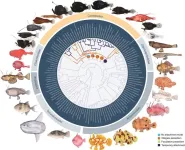(Press-News.org) Tafadzwa Chaunzwa, MD, a researcher in the Artificial Intelligence in Medicine (AIM) Program at Mass General Brigham and a senior resident physician at the Harvard Radiation Oncology Program, is the lead author of a paper published in JAMA Oncology. Chaunzwa and senior author Hugo Aerts, PhD, director of the AIM Program, and associate professor at Harvard University, shared highlights from their paper.
How would you summarize your study for a lay audience?
As treatments like immunotherapy improve cancer survival rates, there is a growing need for clinical decision-support tools that predict treatment response and patient outcomes. This is particularly important for lung cancer, which remains the top cause of cancer death globally. Previous studies linked body mass index (BMI) with lung cancer outcomes and immunotherapy drug side effects. However, BMI is a limited measure that doesn't capture details about different body tissues and their interaction with cancer therapies. We used medical imaging and artificial intelligence (AI) to analyze body composition in a large cohort of patients with lung cancer that has spread to other parts of the body. Our study found that changes in muscle mass and fat quality during treatment are important indicators of outcomes for this population.
What knowledge gaps does your study help to fill?
As we continue to improve the treatment of advanced lung cancer with different systemic agents, including immunotherapy drugs, biomarkers that are both prognostic and predictive of treatment response are increasingly needed to inform clinical decisions. Prior studies identified an association between BMI and lung cancer outcomes. An association between BMI and the incidence of side effects with immunotherapy has also been elucidated. However, BMI alone is a crude metric that does not capture the distribution and relative contributions of different body tissues. Medical imaging-based analyses of body composition are being increasingly explored; however, in the setting of advanced non-small cell lung cancer (NSCLC), studies have been limited by small sample sizes and manual and difficult-to-reproduce methodologies.
How did you conduct your study?
We set out to perform comprehensive body composition analysis in large cohorts of individuals treated for advanced or metastatic lung cancer with different systemic drugs. We developed a robust end-to-end AI-based platform to assist with this task.
What did you find?
We found that while the distribution of different tissue compartments at the start of cancer-directed treatment had some value, the change in these measurements over the course of treatment was more strongly associated with patient outcomes. Specifically, we found that loss in muscle mass was a poor prognostic factor in patients treated with chemotherapy, immunotherapy, or chemoimmunotherapy. Interestingly, among patients receiving immunotherapy, either alone or in combination with chemotherapy, changes in the quality of the fat under the skin (subcutaneous adipose tissue), as seen on CT scans, were also associated with the risk for lung cancer progression or mortality.
What are the implications?
This study presents key breakthroughs that will help advance the prognostication and surveillance of patients receiving immunotherapy for NSCLC. The first breakthrough is the implementation of an automated AI-based pipeline for comprehensive body composition analysis at scale in a diverse population of patients receiving immunotherapy and cytotoxic chemotherapy for advanced NSCLC. This is the largest and most extensive such study, incorporating both real-world data and prospective clinical trial cohorts, with longitudinal collection of multimodal data and extended follow-up to monitor disease response to therapy. Our results demonstrate the potential of this analysis framework to provide a more nuanced understanding of the relationship between body composition and response to immunotherapy in NSCLC compared to crude BMI measurements. This may have important clinical implications for patient selection, treatment, and monitoring. The second contribution is sharing this robust end-to-end deep-learning pipeline for automated slice selection and body compartment segmentation on cross-sectional imaging.
What are the next steps?
We offer the software as an open-source AI tool that seamlessly integrates with platforms for image analysis and also disseminate it on the modelhub.ai platform. By making this algorithm publicly available, we hope to accelerate future studies in this domain and further facilitate the development of novel approaches for analyzing complex cancer imaging data sets. This will allow further investigation of important associations established using BMI or manual CT-based body composition measurements. More broadly, advances in this research area will help guide the management of different cancers and improve our capacity for precision oncology.
Authorship: In addition to Chaunzwa and Aerts, additional Mass General Brigham authors include Jack M. Qian, Leonard Nuernberg, Justin W. Johnson, and Raymond H. Mak. Additional authors include Qin Li, Biagio Ricciuti, Jakob Weiss, Zhongyi Zhang, Jamie McKay, Ioannis Kagiampakis, Damian Bikiel, Alessandro Di Federico, Joao V. Alessi, Etai Jacob, and Mark M. Awad.
Paper cited: Chaunzwa, T et al. “Body Composition in Advanced Non-Small Cell Lung Cancer Treated with Immunotherapy” JAMA Oncology DOI: 10.1001/jamaoncol.2024.1120
END
Research spotlight: AI enabled body composition analysis predicts outcomes for patients with lung cancer treated with immunotherapy
2024-05-23
ELSE PRESS RELEASES FROM THIS DATE:
Silky shark makes record breaking migration
2024-05-23
In a recent study, researchers from the Charles Darwin Foundation (CDF), in collaboration with the Guy Harvey Research Institute (GHRI) and Save Our Seas Foundation Shark Research Center (SOSF-SRC) at Nova Southeastern University in Florida, and the Galapagos National Park Directorate (GNPD) have documented the most extensive migration ever recorded for a silky shark (Carcharhinus falciformis), revealing critical insights into the behavior of this severely overfished species and emphasizing the urgent need for cooperative international management measures to prevent further population declines.
The ...
Sexual parasitism helped anglerfish invade the deep sea during a time of global warming
2024-05-23
Members of the vertebrate group including anglerfishes are unique in possessing a characteristic known as sexual parasitism, in which males temporarily attach or permanently fuse with females to mate. Now, researchers reporting in the journal Current Biology on May 23 show that sexual parasitism arose during a time of major global warming and rapid transition for anglerfishes from the ocean floor to the deep, open sea.
The findings have implications for understanding evolution and the effects that global warming may have in the deep sea, according to the researchers.
“Our results show how the ...
Archaeology: Differences in Neanderthal and Palaeolithic human childhood stress
2024-05-23
Neanderthal children (who lived between 400,000 and 40,000 years ago) and modern human children living during the Upper Palaeolithic era (between 50,000 and 12,000 years ago) may have faced similar levels of childhood stress but at different developmental stages, according to a study published in Scientific Reports. The authors suggest that these findings could reflect differences in childcare and other behavioural strategies between the two species.
Laura Limmer, Sireen El Zaatari and colleagues analysed the dental enamel of 423 Neanderthal teeth (from 74 Homo neanderthalensis individuals) and 444 Upper Palaeolithic humans (from 102 Homo sapiens ...
Rising temperatures will significantly reduce streamflow in the upper Colorado river basin as groundwater levels fall, new research shows
2024-05-23
The Colorado River makes life possible in many Western cities and supports agriculture that sustains people throughout the country. Most of the river’s water begins as snowmelt from the mountainous watersheds of Colorado, Utah, and Wyoming, and a warming climate will drastically reduce these streamflows, new research finds.
Researchers from Desert Research Institute (DRI), USGS, and Lawrence Berkeley National Laboratory teamed up for the new study, published May 23 in Nature Water. By applying warming to historical conditions for the East River in Colorado and using computer simulations to observe the impact on streamflow and groundwater ...
Prenatal exposure to chemical mixtures and metabolic syndrome risk in children
2024-05-23
About The Study: The findings of this cohort study suggest that prenatal exposure to endocrine-disrupting chemical mixtures may be associated with adverse metabolic health in children. Given the pervasive nature of endocrine-disrupting chemicals and the increase in metabolic syndrome, these findings hold substantial public health implications.
Corresponding Author: To contact the corresponding author, Martine Vrijheid, Ph.D., email martine.vrijheid@isglobal.org.
To access the embargoed study: Visit our For The Media ...
Effectiveness of a school- and primary care–based HPV vaccination intervention
2024-05-23
About The Study: In this cluster randomized trial, within the context of the late COVID-19 pandemic period and limited school and general practitioner participation, at-school human papillomavirus (HPV) vaccination significantly increased vaccination coverage. The trial did not show a significant effect for training general practitioners and education and motivation, although it may be observed after more time has elapsed after the intervention.
Corresponding Author: To contact the corresponding author, Morgane Michel, Ph.D., email morgane.michel@aphp.fr.
To access the embargoed study: Visit our For The Media website at this link https://media.jamanetwork.com/
(doi:10.1001/jamanetworkopen.2024.11938)
Editor’s ...
Exposure to mixtures of endocrine-disrupting chemicals during pregnancy is associated with higher odds of metabolic syndrome in children
2024-05-23
The term ‘metabolic syndrome’ (MetS) encompasses a group of factors, such as abdominal obesity, hypertension and insulin resistance, that together increase the risk of cardiovascular disease and type 2 diabetes. A new study suggests that prenatal exposure to a combination of endocrine disrupting chemicals (EDCs) is associated with a poorer metabolic health in childhood, which in turn may contribute to an increased risk of metabolic syndrome in adulthood. The research, led by the Barcelona Institute for Global Health (ISGlobal), a centre supported by the "la Caixa" Foundation, has been published in JAMA Network Open.
EDCs ...
Sea of love: Behind the unusual sexual parasitism of deep-water anglerfishes
2024-05-23
New Haven, Conn. – As the planet’s most expansive ecosystem, the deep sea can be a tough place to find a mate. Though, scientists say, some deep-sea anglerfishes evolved a unique method of reproduction that ensures that once they land a partner in the vast open waters, they remain latched for life.
These anglerfishes, called ceratioids, reproduce through sexual parasitism, in which the tiny males attach to their much larger female counterparts to mate. In some species, the males bite the females ...
USTC proposes therapeutic approach for inflammatory bowel disease
2024-05-23
In a study published in Cell Host & Microbe, a research team led by Prof. PAN Wen from the University of Science and Technology of China (USTC) of the Chinese Academy of Sciences, in collaboration with research teams led by Prof. ZHU Shu and Prof. SONG Xinyang, demonstrated the causal link between microbial factors and dysfunction of intestinal stem cells (ISCs) in colitis. On the basis of this mechanism, they proposed a possible approach to restore ISC function in colitis.
Inflammatory bowel disease (IBD) is a chronic disease characterized by the microbial ...
International planet hunters unveil massive catalog of strange worlds
2024-05-23
While thousands of planets have been discovered around other stars, relatively little is known about them. A NASA catalog featuring 126 exotic, newly discovered worlds includes detailed measurements that allow for comparisons with our own solar system.
The catalog details a fascinating mix of planet types beyond our solar system, from rare worlds with extreme environments to ones that could possibly support life.
The planets were analyzed by a large, international team of scientists using NASA’s Transiting Exoplanet Survey Satellite (TESS) in collaboration with the W.M. Keck Observatory on Maunakea, Hawai’i. They are described in today’s edition of The Astrophysical ...




